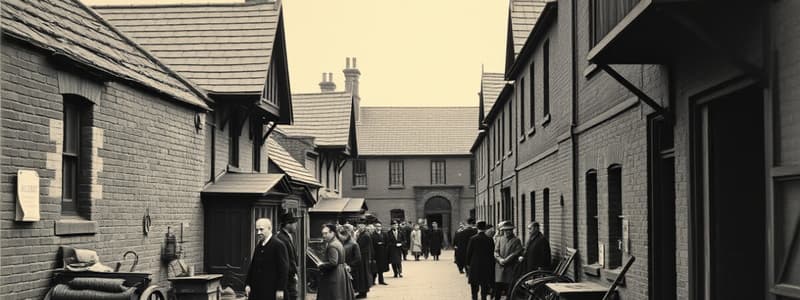Podcast
Questions and Answers
What percentage of people in London lived in abject poverty during the Victorian era?
What percentage of people in London lived in abject poverty during the Victorian era?
- 35% (correct)
- 30%
- 25%
- 40%
What was the purpose of the New Poor Law passed in 1834?
What was the purpose of the New Poor Law passed in 1834?
- To send the poor to workhouses (correct)
- To increase wages for factory workers
- To improve working conditions for laborers
- To provide more financial support to the poor
Which of the following jobs was commonly performed in workhouses?
Which of the following jobs was commonly performed in workhouses?
- Unpicking rope (correct)
- Clerical work
- Teaching children
- Manufacturing textiles
What was a common perception of workhouses among wealthy people?
What was a common perception of workhouses among wealthy people?
What happened to families that were sent to workhouses?
What happened to families that were sent to workhouses?
What was the role of the government regarding pensions during the Victorian period?
What was the role of the government regarding pensions during the Victorian period?
What was the common perception of workhouses during the Victorian period?
What was the common perception of workhouses during the Victorian period?
How were elderly individuals viewed in terms of work during the Victorian period?
How were elderly individuals viewed in terms of work during the Victorian period?
What was a consequence for individuals who ended up in workhouses?
What was a consequence for individuals who ended up in workhouses?
Why did the government believe that instilling fear about workhouses would be effective?
Why did the government believe that instilling fear about workhouses would be effective?
Flashcards are hidden until you start studying
Study Notes
Workhouses in Victorian Britain
- Approximately 35% of London's population lived in severe poverty during the Victorian era.
- Poverty was largely caused by low wages set by wealthy factory owners who prioritized profits over worker welfare.
- In 1834, the New Poor Law was enacted, worsening conditions for the impoverished and forcing them into workhouses.
- Workhouses had existed since the 1380s, where individuals worked in exchange for meager wages and basic food, often in harsh conditions.
- Common jobs in workhouses included unpicking rope and smashing rocks, which were physically demanding and undesirable.
- Families were often separated upon entering workhouses, leading to a high likelihood of never reuniting.
- Workhouses were colloquially known as “prisons for the poor,” reflecting their harsh realities and the stigma associated with them.
- Wealthy individuals often portrayed poor families as eager to enter workhouses, obscuring the grim truth of their situation.
- Unlike today, there were no pensions for elderly people in the Victorian era; they were expected to work until they could no longer do so.
- The government believed that the fear of workhouses would motivate individuals to secure employment, despite the scarcity of jobs and low wages.
- Workers in workhouses were compelled to wear uniforms, marking them as society's poorest and subjecting them to humiliation.
- Thousands of poor individuals lived on the streets or in dire conditions, with little care given by those managing the workhouses.
Studying That Suits You
Use AI to generate personalized quizzes and flashcards to suit your learning preferences.




